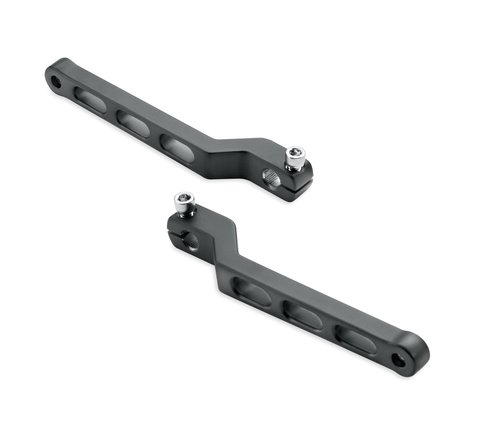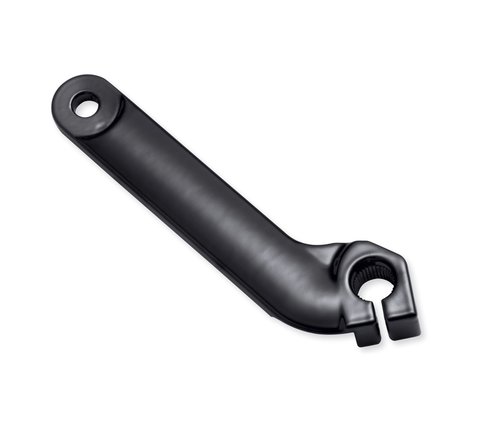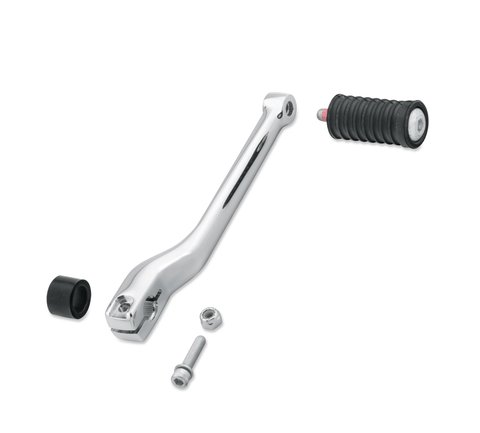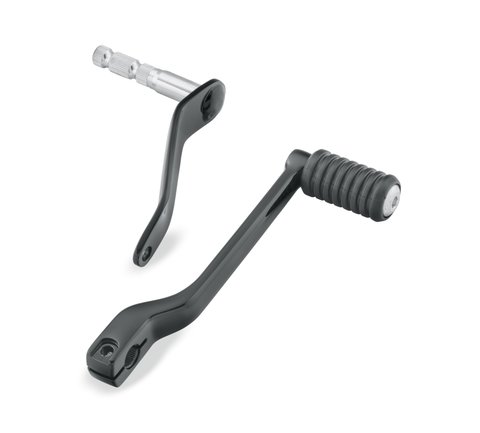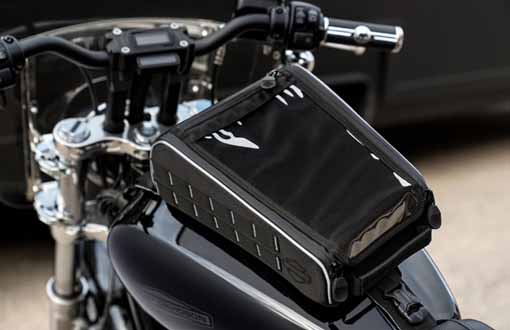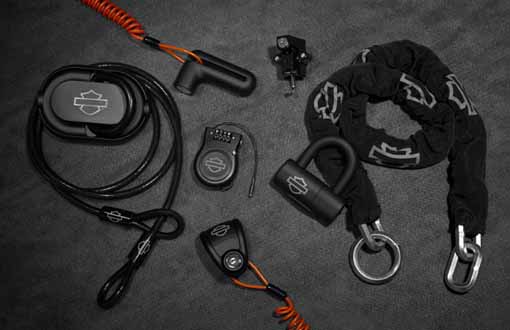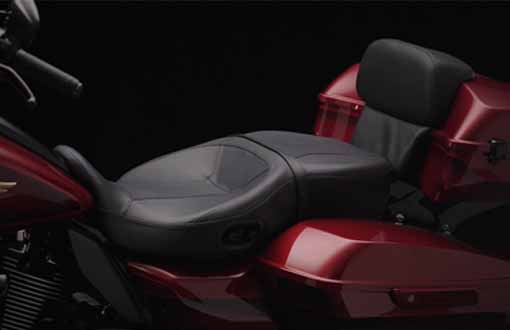Many Harley-Davidson® motorcycles have been equipped with a heel/toe shifting mechanism, a feature that is almost exclusive to Harley-Davidson® bikes. Many riders prefer the function and the look of a heel/toe shifter. But what exactly is a heel/toe shifter? Here’s what you need to know about heel/toe shifting on a motorcycle.
Heel Toe Shifting History
Before 1952, all Harley-Davidson® Big Twin and 45 cubic inch motorcycles had a hand-operated gear shift lever located on the left side of the fuel tank. The clutch was controlled with a heel/toe “rocker” forward of the left side foot board. In 1952, Harley offered for these models the option of a hand clutch and shifting through a left foot control – the set-up that is standard today. That foot control featured two levers, one positioned near the rider’s toe or the ball of the foot and the other positioned to the rear, which was actuated by the rider’s boot heel. The forward lever shifts the transmission down while the rear lever accomplishes upshifts.
The reason Harley-Davidson fitted a heel/toe shifter, rather than just a toe shift lever, is lost to history. The design may have seemed logical given that the foot clutch had heel/toe levers and footpads. This design also prevented scuffing the top of the left boot that would occur when upshifting with the toe. Many veteran riders still preferred the foot clutch/hand shift set-up, and Harley-Davidson continued to offer the foot clutch and hand shift as an option on Big Twin models until 1978, when a new transmission was introduced. By then it was almost exclusively ordered for police motorcycles, as officers could operate a radio microphone with their left hand and clutch with their left foot.
How Does Heel/Toe Shifting Work?
To up-shift the transmission, the rider taps down on the rear shift lever with their heel. Downshifts are made by tapping the forward shift lever with the toe of the boot. If they prefer, the rider may also upshift by lifting the forward shift peg with the top of their boot.
Both shift levers fit over a splined shaft and the angle of the lever can be adjusted up and down in small increments to best fit a rider’s foot size or preference. Because the heel/toe shift feature has been almost exclusive to Harley-Davidson® touring motorcycles, riders coming off other bike brands may find the two-lever control requires an adjustment in riding habits. Riders who don’t care to use it simply can remove the rear shift lever and just use the front lever for up and down shifts.
Harley-Davidson has only offered heel/toe shifting on motorcycle models equipped with rider footboards because the rider may need additional flexibility to move their foot forward and back to reach the two levers.
Riders who prefer heel/toe shifting – either for convenience or for the classic look it offers – can install a heel shift, choosing from several styles, including extended reach levers that may be a better fit for tall riders or those with larger boots.
Shop Harley Shift Levers
Learn To Shift
Shifting motorcycle gears is simpler than you might think. All you need to do is learn the three basic controls and what to do with them to shift your motorcycle.
Watch video to learn more about how to shift on a motorcycle.
Learn more about motorcycles and the freedom of riding from Expert Advice articles or visit the experts at your local authorized Harley-Davidson® dealer.
Advice to Help You Choose
Explore the latest Parts & Apparel
Andorra - español
Argentina – español
Australia – English
Belgique – français
België – Nederlands
Brasil – português
Canada – English
Canada – français
Česká Republika – Česky
Chile – español
中国 - 中文
Colombia – español
Danmark – dansk
Deutschland – deutsch
España – español
France – français
Hong Kong, China – English
India – English
Indonesia – Bahasa Indonesia
Ireland – English
Italia – italiano
Japan – Japanese
Jordan – English
Korea – 한국어
العربية – دولة الكويت
Kuwait – English
Luxembourg – français
Macau, China – English
Magyarország – magyar
Malaysia – English
México – español
Middle East - English
Middle East - العربية
Myanmar – English
Nederland – nederlands
New Zealand – English
Norge – norsk
Österreich – deutsch
Philippines – English
Polska – polski
Portugal – Português
Puerto Rico - English
Qatar – English
România – English
العربية – المملكة العربية السعودية
Saudi Arabia – English
Schweiz – deutsch
Singapore – English
Slovensko – Česky
South Africa – English
Suisse – français
Suomi - Suomeksi
Sverige - Svensk
Svizzera – italiano
Taiwan, China - 中文
Thailand - Thai
Türkiye – Türk
العربية - الامارات العربية المتحدة
United Arab Emirates – English
United Kingdom – English
United States – English
Vietnam – Vietnamese
America latina - española
African Markets – English
Asia Pacific Markets - English
Česká Republika/Slovensko – Česky
European Markets - English
Kuwait – English
Middle East - English
Myanmar – English
Česká Republika/Slovensko – Česky
العربية - الامارات العربية المتحدة
Sverige - Svensk
Malaysia – English
Portugal – Português
Slovensko – Česky
Saudi Arabia – English
Luxembourg – français
Suomi - Suomeksi
Chile – español
Česká Republika – Česky
Suisse – français
België – Nederlands
Colombia – español
Argentina – español
Japan – Japanese
Türkiye – Türk
Asia Pacific Markets - English
India – English
United Arab Emirates – English
Norge – norsk
European Markets - English
Nederland – nederlands
United Kingdom – English
African Markets – English
Schweiz – deutsch
Singapore – English
العربية – دولة الكويت
Canada – français
Österreich – deutsch
New Zealand – English
中国 - 中文
Qatar – English
România – English
America latina - española
España – español
Macau, China – English
العربية – المملكة العربية السعودية
Svizzera – italiano
Danmark – dansk
Brasil – português
Canada – English
Taiwan, China - 中文
Thailand - Thai
Deutschland – deutsch
Andorra - español
Ireland – English
France – français
Jordan – English
Puerto Rico - English
Belgique – français
Korea – 한국어
United States – English
Vietnam – Vietnamese
Philippines – English
Italia – italiano
Polska – polski
Middle East - العربية
Hong Kong, China – English
South Africa – English
México – español
Australia – English
Magyarország – magyar
Indonesia – Bahasa Indonesia
-
Recommended 91 octane (95 RON) or higher fuel (R+M)/2.
-
Values shown are nominal. Performance may vary by country and region.
-
Standard and optional fuel systems may vary by country.
-
See motorcycle owner’s manual for complete details.
-
Estimated from fuel economy tests on a sample motorcycle from the corresponding family conducted by Harley-Davidson under ideal laboratory conditions. Not all motorcycle models undergo fuel economy testing. Fuel economy and mileage may vary among motorcycle models within a family. Your mileage may vary depending on your personal riding habits, weather conditions, trip length, vehicle condition and vehicle configuration and other conditions. Break-in mileage may vary.
-
Prices listed are the Manufacturer’s Suggested Retail Prices for base models. Options such as color are available at additional cost. Prices exclude tax, title, licensing, registration fees, destination charges, surcharges (attributable to raw materials costs in the product supply chain), added accessories, and additional dealer charges, if any, and are subject to change. Harley-Davidson reimburses dealers for performing manufacturer-specified pre-delivery inspection and setup tasks. Dealer prices may vary.
-
Measurement reflects 180 lb. (81.7 kg) operator weight.
-
North America security system includes immobilizer; outside North America the security system includes immobilizer and siren.
-
Standard and optional wheels may vary by country and region.
-
Financing Offer available only on new 2024 Harley-Davidson® Ultra Limited® and 2024 Road Glide® 3 motorcycles financed through Eaglemark Savings Bank (ESB) and is subject to credit approval. Not all applicants will qualify. 1.49% APR offer is available only to high credit tier customers at ESB and only for a 48-month term. The APR may vary based on the applicant’s past credit performance and the term of the loan. For example, a 2024 Ultra Limited® model in Billiard Gray with an MSRP of $32,499, no down payment and amount financed of $32,499, 48-month repayment term, and 1.49% APR results in monthly payments of $697.86. Also, for example, a 2024 Road Glide® 3 model in Atlas Silver Metallic with an MSRP of $35,999, no down payment and amount financed of $35,999, 48-month repayment term, and 1.49% APR results in monthly payments of $773.02. In these examples, customer is responsible for applicable taxes, title, licensing fees and any other fees or charges at the time of sale. APR is calculated according to the simple interest method. Not valid in conjunction with other offers. This Financing Offer is valid during the period of January 30, 2025 - March 31, 2025. Other terms, conditions, and limitations may apply. Dealer participation may vary. Financing offer is subject to change or cancellation at anytime.
-
Financing Offer available for Used Harley‑Davidson® motorcycles financed through Eaglemark Savings Bank (ESB) and is subject to credit approval. Not all applicants will qualify. 7.44% APR offer is available on Used Harley‑Davidson® motorcycles to high credit tier customers at ESB and only for up to a 60 month term. The APR may vary based on the applicant’s past credit performance and the term of the loan. For example, a 2023 Softail® Standard motorcycle in Vivid Black with a sale price of $14,399, no down payment and amount financed of $14,399, 60 month repayment term, and 7.44% APR results in monthly payments of $288.12. In this example, customer is responsible for applicable taxes, title, licensing fees and any other fees or charges at the time of sale. APR is calculated according to the simple interest method. Not valid in conjunction with other offers. Other terms, conditions, and limitations may apply. Dealer participation may vary. Financing offer is subject to change or cancellation at any time. See your Harley‑Davidson® Dealership for details.
-
$0 Down and as Low as 3.99% APR
*Financing Offer available only on select, untitled 2022 and 2023 Harley-Davidson® Grand American Touring, Adventure Touring, Trike, CVO™, Softail® and Custom motorcycles financed through Eaglemark Savings Bank and is subject to credit approval. Touring models Road King® Special and Electra Glide® Highway King are excluded. Harley-Davidson® Anniversary and Icons Motorcycle Collection are excluded. Not all applicants will qualify as the Annual Percentage Rate (APR) will vary based on the applicant’s past credit performance and the term of the loan. Financing offer is available only for up to a 60-month term. For example, a 2023 Street Glide® Special motorcycle in Bright Billiard Blue/Billiard Gray with Chrome Finish and an MSRP of $29,499, no down payment and amount financed of $29,499, 60-month repayment term, and 3.99% APR results in monthly payments of $543.14. In this example, customer is responsible for applicable taxes, title, licensing fees and any other fees or charges at the time of sale. APR is calculated according to the simple interest method. Not valid in conjunction with other offers. Customer must take delivery by October 31, 2024. This Financing Offer is valid during the period of August 27, 2024, to October 31, 2024. Other terms, conditions, and limitations may apply. Dealer participation may vary. Financing offer is subject to change or cancellation at anytime. See your Harley-Davidson® Dealership for details.CUSTOMIZATION CREDIT
**Up to $2,000 incentive valid for in-dealership purchase of Genuine Harley-Davidson® Parts & Accessories and/or Apparel & Licensed merchandise in connection with the purchase of select Grand American Touring, Trike and Softail motorcycles valid at participating Harley-Davidson® dealerships within the U.S. including Alaska and Hawaii. Offer valid toward the purchase of select new, untitled 2022 or 2023 Harley-Davidson® Grand American Touring, Trike and Softail motorcycles available and in stock at participating H-D® dealers between August 27, 2024 and October 31, 2024. Offer may not be available in all states. Touring models Road King® Special, Road Glide®, Street Glide® and Electra Glide® Highway King are excluded. Harley-Davidson® Anniversary, CVO™, Icons Motorcycle Collection and Police Duty Motorcycles are excluded. Offer cannot be redeemed for cash or cash equivalent. Offer is subject to change at any time without notice. Void where prohibited or restricted by law. Dealer participation may vary. Additional restrictions apply, see your Harley-Davidson® Dealership for details. -
Financing Offer available only on new Harley-Davidson® motorcycles financed through Eaglemark Savings Bank (ESB) and is subject to credit approval. Not all applicants will qualify. This 11.84% offer is available on new Harley Davidson® motorcycles to high credit tier customers at ESB and only for up to an 84-month term. The APR may vary based on the applicant’s past credit performance and the term of the loan. For example, a 2024 Pan America® 1250 Special motorcycle in Billiard Gray with an MSRP of $19,999, 10% down payment and amount financed of $17,999.10, 84-month repayment term, and 11.84% APR results in monthly payments of $316.20. In this example, customer is responsible for applicable taxes, title, licensing fees and any other fees or charges at the time of sale. APR is calculated according to the simple interest method. Not valid in conjunction with other offers. Other terms, conditions, and limitations may apply. Dealer participation may vary. Financing offer is subject to change or cancellation at any time. See your Harley-Davidson® Dealership for details.
-
Financing Offer available only on new Harley-Davidson® motorcycles financed through Eaglemark Savings Bank (ESB) and is subject to credit approval. Not all applicants will qualify. This 12.74% offer is available on new Harley Davidson® motorcycles to high credit tier customers at ESB and only for up to a 96-month term. The APR may vary based on the applicant’s past credit performance and the term of the loan. For example, a 2024 Street Glide® motorcycle in Billiard Gray with an MSRP of $25,999, 10% down payment and amount financed of $23,399.10, 96-month repayment term, and 12.74% APR results in monthly payments of $389.88. In this example, customer is responsible for applicable taxes, title, licensing fees and any other fees or charges at the time of sale. APR is calculated according to the simple interest method. Not valid in conjunction with other offers. Other terms, conditions, and limitations may apply. Dealer participation may vary. Financing offer is subject to change or cancellation at any time. See your Harley-Davidson® Dealership for details.
-
Prices listed are the Manufacturer’s Suggested Retail Prices (MSRP). MSRP excludes tax, title, licensing, registration fees, destination charges (including freight, handling and processing), surcharges (attributable to raw materials cost in the product supply chain), dealer-added accessories and installation, and additional dealer charges, if any. Harley-Davidson charges dealers for destination charges (including freight, handling and processing) and may make a profit on those charges. Harley-Davidson reimburses dealers for performing manufacturer-specified pre-delivery inspection and setup tasks. Dealer prices may vary.
-
Financing Offer available only on new Harley‑Davidson® motorcycles financed through Eaglemark Savings Bank (ESB) and is subject to credit approval. Not all applicants will qualify. 5.99% APR offer is available only to high credit tier customers who have completed a Riding Academy, Skilled Riders, MSF or other state accredited course within 180 days of application date and only for up to a 60 month term. The APR may vary based on the applicant’s past credit performance and the term of the loan. For example, a 2025 Heritage Classic motorcycle in Billard Gray with an MSRP of $22,999, 10% down payment and amount financed of $20,699.10, 60 month repayment term, and 5.99% APR results in monthly payments of $400.08. In this example, customer is responsible for applicable taxes, title, licensing fees and any other fees or charges at the time of sale. APR is calculated according to the simple interest method. Not valid in conjunction with other offers. Other terms, conditions, and limitations may apply. Dealer participation may vary. Financing offer is subject to change or cancellation at anytime. See your Harley-Davidson® Dealership for details.
-
Financing Offer available only on used Harley‑Davidson motorcycles financed through Eaglemark Savings Bank (ESB) and is subject to credit approval. Not all applicants will qualify. 6.79% APR offer is available only to high credit tier customers who have completed a Riding Academy, Skilled Riders, MSF or other state accredited course within 180 days of application date and only for up to a 60 month term. The APR may vary based on the applicant's past credit performance and the term of the loan. For example, a 2023 Softail Standard motorcycle in Vivid Black with a sale price of $14,399, no down payment and amount financed of $14,399, 60 month repayment term, and 6.94% APR results in monthly payments of $283.69. In this example, customer is responsible for applicable taxes, title, licensing fees and any other fees or charges at the time of sale. APR is calculated according to the simple interest method. Not valid in conjunction with other offers. Other terms, conditions, and limitations may apply. Dealer participation may vary. Financing offer is subject to change or cancellation at anytime. See your Harley-Davidson® Dealership for details.
-
Visit H-DVisa.com for details. The creditor and issuer of the Harley‑Davidson® Visa® card is U.S. Bank National Association, pursuant to a license from Visa U.S.A. Inc.
-
Financing offer available only to Active United States Military personnel and only on Harley‑Davidson® motorcycles financed through Eaglemark Savings Bank and is subject to credit approval. Not all applicants will qualify. No Money Down offer is available only to well-qualified credit tier applicants. 8.54% APR offer is available only to the highest credit tier applicants and only for up to 60 months term. The APR and down payment may vary based on the applicant’s past credit performance and the term of the loan. For example, a 2023 Street Bob® motorcycle in Billard Gray with an MSRP of $17,199, no down payment and amount financed of $17,199, 60 month repayment term and 8.54% APR results in monthly payments of $353.20. In this example, customer is responsible for applicable taxes, title, licensing fees and any other fees or charges at the time of sale. APR is calculated according to the simple interest method. Not valid in conjunction with other offers. Other terms, conditions and limitations may apply. Financing offer is subject to change or cancellation at any time. See your Harley‑Davidson® Dealership for details. Active Military includes: United States Army, Navy, Marine, Air Force, Coast Guard, National Guard and Reserves.
-
Financing Offer available only on new Harley-Davidson® motorcycles financed through Eaglemark Savings Bank (ESB) and is subject to credit approval. Not all applicants will qualify. This 11.14% offer is available on new Harley Davidson® motorcycles to high credit tier customers at ESB and only for up to an 84-month term. The APR may vary based on the applicant’s past credit performance and the term of the loan. For example, a 2025 Nightster® motorcycle in Billiard Gray with an MSRP of $9,999 a 10% down payment and amount financed of $8,999.10, 84-month repayment term, and 11.14% APR results in monthly payments of $154.75. In this example, customer is responsible for applicable taxes, title, licensing fees and any other fees or charges at the time of sale. APR is calculated according to the simple interest method. Not valid in conjunction with other offers. Other terms, conditions, and limitations may apply. Dealer participation may vary. Financing offer is subject to change or cancellation at any time. See your Harley-Davidson® Dealership for details.
-
Financing Offer available only on new 2024 Street Bob® 114 Harley-Davidson® motorcycles financed through Eaglemark Savings Bank (ESB) and is subject to credit approval. Not all applicants will qualify. 4.35% APR offer is available only to high credit tier customers at ESB and only for a 48-month term. The APR may vary based on the applicant’s past credit performance and the term of the loan. For example, a 2024 Street Bob® 114 motorcycle in Billiard Gray with an MSRP of $16,999, 10% down payment and amount financed of $15,299.10, 48-month repayment term, and 4.35% APR results in 47 monthly payments of $188.72 and a 48th balloon payment of $8,514.41. In this example, customer is responsible for applicable taxes, title, licensing fees and any other fees or charges at the time of sale. APR is calculated according to the simple interest method. Not valid in conjunction with other offers. This Financing Offer is valid during the period of January 2, 2025 - March 31, 2025. Other terms, conditions, and limitations may apply. Dealer participation may vary. Financing offer is subject to change or cancellation at anytime.
Handlebar height is regulated in many locations. Check local laws to ensure your motorcycle meets applicable regulations.
-
Financing Offer available only on new Harley-Davidson® motorcycles financed through Eaglemark Savings Bank (ESB) and is subject to credit approval. Not all applicants will qualify. This 12.14% offer is available on new Harley Davidson® motorcycles to high credit tier customers at ESB and only for up to an 96-month term. The APR may vary based on the applicant’s past credit performance and the term of the loan. For example, a 2025 Street Glide® motorcycle in Billiard Gray with an MSRP of $27,749, a 10% down payment and amount financed of $24,974.10, 96-month repayment term, and 12.14% APR results in monthly payments of $407.82. In this example, customer is responsible for applicable taxes, title, licensing fees and any other fees or charges at the time of sale. APR is calculated according to the simple interest method. Not valid in conjunction with other offers. Other terms, conditions, and limitations may apply. Dealer participation may vary. Financing offer is subject to change or cancellation at any time. See your Harley-Davidson® Dealership for details.
-
Financing Offer available only on select, untitled 2024 Harley-Davidson® Grand American Touring, Adventure Touring, Trike, CVO™, Softail® and Custom motorcycles financed through Eaglemark Savings Bank and is subject to credit approval. Harley-Davidson® Icons Motorcycle Collection are excluded. Not all applicants will qualify as the Annual Percentage Rate (APR) will vary based on the applicant’s past credit performance and the term of the loan. Financing offer is available only for up to a 60-month term. For example, a 2024 Street Glide® motorcycle in Whiskey Fire Red with Chrome Trim and an MSRP of $26,849, no down payment and amount financed of $26,849, 60-month repayment term, and 3.99% APR results in monthly payments of $494.34. In this example, customer is responsible for applicable taxes, title, licensing fees and any other fees or charges at the time of sale. APR is calculated according to the simple interest method. Not valid in conjunction with other offers. Customer must take delivery by October 31, 2024. This Financing Offer is valid during the period of August 27, 2024 to October 31, 2024. Other terms, conditions, and limitations may apply. Dealer participation may vary. Financing offer is subject to change or cancellation at anytime. See your Harley-Davidson® Dealership for details.
-
Prices listed are the Manufacturer’s Suggested Retail Prices for base models. Options such as color are available at additional cost. Prices exclude tax, title, licensing, registration fees, destination charges, surcharges (attributable to raw materials costs in the production supply chain), added accessories, and additional dealer charges, if any, and are subject to change. Harley-Davidson reimburses dealers for performing manufacturer-specified pre-delivery inspection and setup tasks. Dealer prices may vary.
-
Financing Offer available only on new Harley-Davidson® Nightster® motorcycles financed through Eaglemark Savings Bank (ESB) and is subject to credit approval. Not all applicants will qualify. 5.99% APR offer is available only to high credit tier customers who have completed a Riding Academy, Skilled Riders, MSF or other state accredited course within 180 days of application date and only for up to a 60 month term. The APR may vary based on the applicant’s past credit performance and the term of the loan. For example, a 2025 Nightster® motorcycle in Billiard Gray with an MSRP of $9,999, a 10% down payment and amount financed of $8,999.10, 60-month repayment term, and 5.99% APR results in monthly payments of $173.94. In this example, customer is responsible for applicable taxes, title, licensing fees and any other fees or charges at the time of sale. APR is calculated according to the simple interest method. Not valid in conjunction with other offers. This Financing Offer is valid during the period of March 1, 2025 - June 30, 2025. Other terms, conditions, and limitations may apply. Dealer participation may vary. Financing offer is subject to change or cancellation at any time. See your Harley-Davidson® Dealership for details.
-
Financing Offer available only on New 2024 Ultra Limited® Harley-Davidson® motorcycles financed through Eaglemark Savings Bank (ESB) and is subject to credit approval. Not all applicants will qualify. 5.40% APR offer is available only to high credit tier customers at ESB and only for a 48-month term. The APR may vary based on the applicant’s past credit performance and the term of the loan. For example, a 2024 Ultra Limited® motorcycle in Billiard Gray with an MSRP of $32,499, 10% down payment and amount financed of $29,249.10, 48-month repayment term, and 5.40% APR results in 47 monthly payments of $384.89 and a 48th balloon payment of $16,098.14. In this example, customer is responsible for applicable taxes, title, licensing fees and any other fees or charges at the time of sale. APR is calculated according to the simple interest method. Not valid in conjunction with other offers. This Financing Offer is valid during the period of January 30, 2025 - March 31, 2025. Other terms, conditions, and limitations may apply. Dealer participation may vary. Financing offer is subject to change or cancellation at anytime
-
The extension of the Motorcycle Limited Warranty is valid on new, previously untitled 2022, 2023, 2024 and 2025 Harley-Davidson® motorcycles purchased and delivered between November 1, 2024 and March 31, 2025. Offer excludes Company Owned Vehicles (COV), Police Duty Motorcycles, Fleet, EagleRider, and DEMO motorcycles. Warranty coverage on all eligible motorcycles sold and delivered during the sales period will be extended through April 30, 2027. All other terms of the Motorcycle Limited Warranty, which can be found in your Harley-Davidson Owner's Manual, remain the same. See dealer for details.
-
*Financing Offer available only on New 2024 Low Rider® S Harley-Davidson® motorcycles financed through Eaglemark Savings Bank (ESB) and is subject to credit approval. Not all applicants will qualify. 4.88% APR offer is available only to high credit tier customers at ESB and only for a 48-month term. The APR may vary based on the applicants past credit performance and the term of the loan. For example, a 2024 Low Rider® S in Billiard Gray with an MSRP of $19,999, 10% down payment and amount financed of $17,999.10, 48-month repayment term, and 4.88% APR results in 47 monthly payments of $228.95 and a 48th balloon payment of $9,991.13. In this example, customer is responsible for applicable taxes, title, licensing fees and any other fees or charges at the time of sale. APR is calculated according to the simple interest method. Not valid in conjunction with other offers. This Financing Offer is valid during the period of April 1, 2025 – June 30, 2025. Other terms, conditions, and limitations may apply. Dealer participation may vary. Financing offer is subject to change or cancellation at any time.
**Customers who choose the return option will need to pay the balance of the loan, which will vary depending on when the bike is returned, along with a return fee of up to $395 and any costs to repair excess wear and tear.
-
$1 H-D™ Extended Service Plan (“ESP”) offer is only available to customers who purchase a new (untitled) H-D® Pan America motorcycle (excluding demos, rentals, Company Owned Vehicles (COV), Police, and fleet). $1 cost applies only to the standard 3-year term H-D™ ESP. You may be able to purchase additional terms, Optional Screamin’ Eagle coverage and/or Tire and Wheel protection for an additional charge. The H-D® promotion period runs from 1/27/2025 through 12/31/2025. You must take delivery of the eligible Pan America motorcycle by 12/31/2025 to qualify. Offer valid at all Harley-Davidson dealers authorized to sell H-D™ ESP, excluding Florida. Off-road riding is regulated in some areas—ALWAYS check state and local requirements before riding. The ESP purchase does not have to be financed. Refer to the ESP contract for terms and conditions. Not all parts and services are covered. See the H-D™ ESP for specific obligations, conditions, limitations, exclusions, and state-specific provisions related to coverage or benefits. The Expense Reimbursement Package and Optional Tire & Wheel Coverage begin the same day you purchase your motorcycle, while the Mechanical Breakdown Coverage begins the day after your factory warranty expires. All coverages continue for the term of the ESP subject to all terms and conditions. The H-D™ ESP is available for review prior to purchase. The provider under the H-D™ ESP is Continental Service Provider, Inc. or Continental Service Plan, Inc., 4150 Drinkwater Blvd., Suite 400, Scottsdale, AZ 85251. ©2024 H-D® or its Affiliates, Harley-Davidson, Harley, H-D® and the Bar & Shield logo are among the trademarks of Harley-Davidson Motor Company, Inc., 3700 W. Juneau Avenue, Milwaukee, WI 53208
-
NO PURCHASE/PAYMENT NECESSARY Offered only to Harley-Davidson® riders, above age of majority & legal US/DC residents (excludes HI). Other restrictions apply. Starts 3/28/2025 & ends 10/31/2025. You must have smartphone/mobile device capable of scanning QR Codes to register (one time only) & obtain periodic mileage validations at a participating Harley-Davidson® dealership to compete. DATA RATES MAY APPLY. MAY NOT BE AVAIL IN ALL AREAS OR ON ALL DEVICES. Other restrictions apply. For full rules visit h-dletsride.com. Sponsor/Operator: Mighty Loud, Inc. Void where prohibited. Donations made to military, veteran and first responder organizations will not affect participation in this challenge.
-
*Financing Offer available only on new 2024 Harley-Davidson® Road Glide® 3 motorcycles financed through Eaglemark Savings Bank (ESB) and is subject to credit approval. Not all applicants will qualify. 1.49% APR offer is available only to high credit tier customers at ESB and only for a 48-month term. The APR may vary based on the applicant’s past credit performance and the term of the loan. For example, a 2024 Road Glide® 3 model in Atlas Silver Metallic with Black Trim with an MSRP of $37,099, no down payment and amount financed of $37,099, 48-month repayment term, and 1.49% APR results in monthly payments of $796.64. In these examples, customer is responsible for applicable taxes, title, licensing fees and any other fees or charges at the time of sale. APR is calculated according to the simple interest method. Not valid in conjunction with other offers. This Financing Offer is valid during the period of April 1, 2025 - June 30, 2025. Other terms, conditions, and limitations may apply. Dealer participation may vary. Financing offer is subject to change or cancellation at anytime.
-
Terms, conditions, and additional fees apply. Motorcycles may be ineligible for return due to excess wear and tear, excessive modifications, or other conditions.
-
Financing Offer available only on New Harley-Davidson® motorcycles financed through Eaglemark Savings Bank (ESB) and is subject to credit approval. Not all applicants will qualify. 8.34% APR offer is available only to high credit tier customers at ESB and only for a 48-month term. The APR may vary based on the applicant s past credit performance and the term of the loan. For example, a 2025 Road Glide® in Billiard Gray with an MSRP of $27,999, 10% down payment and amount financed of $25,199.10, 48-month repayment term, and 8.34% APR results in 47 monthly payments of $339.02 and a 48th balloon payment of $16,238.67. In this example, customer is responsible for applicable taxes, title, licensing fees and any other fees or charges at the time of sale. APR is calculated according to the simple interest method. Not valid in conjunction with other offers. This Financing Offer is valid during the period of March 1, 2025 – April 30, 2025. Other terms, conditions, and limitations may apply. Dealer participation may vary. Financing offer is subject to change or cancellation at anytime.
-
Financing Offer available only on select new 2024 Harley-Davidson® Softail® motorcycles financed through Eaglemark Savings Bank (ESB) and is subject to credit approval. Excludes 2024 Softail® Standard. Not all applicants will qualify. 1.49% APR offer is available only to high credit tier customers at ESB and only for a 48-month term. The APR may vary based on the applicant’s past credit performance and the term of the loan. For example, a 2024 Fat Boy® motorcycle in Sharkskin Blue with an MSRP of $22,649, no down payment and amount financed of $22,649, 48-month repayment term, and 1.49% APR results in monthly payments of $486.35. In this example, customer is responsible for applicable taxes, title, licensing fees and any other fees or charges at the time of sale. APR is calculated according to the simple interest method. Not valid in conjunction with other offers. This Financing Offer is valid during the period of January 2, 2025 - March 31, 2025. Other terms, conditions, and limitations may apply. Dealer participation may vary. Financing offer is subject to change or cancellation at anytime.
-
N/A
-
NA
-
N/A
-
N/A
-
N/A
-
N/A
-
Financing Offer available only on new Harley-Davidson® motorcycles financed through Eaglemark Savings Bank (ESB) and is subject to credit approval. Not all applicants will qualify. This 12.74% offer is available on new Harley Davidson® motorcycles to high credit tier customers at ESB and only for up to a 96-month term. The APR may vary based on the applicant’s past credit performance and the term of the loan. For example, a 2024 Road Glide® motorcycle in Billiard Gray with an MSRP of $25,999, 10% down payment and amount financed of $23,399.10, 96-month repayment term, and 12.74% APR results in monthly payments of $389.88. In this example, customer is responsible for applicable taxes, title, licensing fees and any other fees or charges at the time of sale. APR is calculated according to the simple interest method. Not valid in conjunction with other offers. Other terms, conditions, and limitations may apply. Dealer participation may vary. Financing offer is subject to change or cancellation at any time. See your Harley-Davidson® Dealership for details.
-
Financing Offer available only on new Harley-Davidson® motorcycles financed through Eaglemark Savings Bank (ESB) and is subject to credit approval. Not all applicants will qualify. This 11.84% offer is available on new Harley Davidson® motorcycles to high credit tier customers at ESB and only for up to an 84-month term. The APR may vary based on the applicant’s past credit performance and the term of the loan. For example, a 2024 Nightster® motorcycle in Billiard Gray with an MSRP of $11,999, 10% down payment and amount financed of $10,799.10, 84-month repayment term, and 11.84% APR results in monthly payments of $189.14. In this example, customer is responsible for applicable taxes, title, licensing fees and any other fees or charges at the time of sale. APR is calculated according to the simple interest method. Not valid in conjunction with other offers. Other terms, conditions, and limitations may apply. Dealer participation may vary. Financing offer is subject to change or cancellation at any time. See your Harley-Davidson® Dealership for details.

